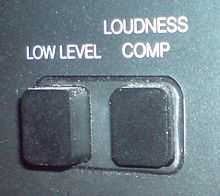Loudness compensation

Loudness compensation is a setting found on some hi-fi equipment and equalisers that increases the level of the high and low frequencies.[1] This is intended to be used at low listening levels, to compensate for the fact that as the volume of audio decreases, the ears lower sensitivity to extreme high and low frequencies may cause these signals to fall below threshold.[2] As a result audio material may seem to become 'thin' sounding at low volumes, losing bass and treble, the 'Loudness compensation' button (often just labelled 'Loudness' or 'Loud') is intended to rectify this situation. See the section on Loudness for a more detailed explanation of the ears' sensitivity to sound as a function of frequency.
Loudness compensation is difficult to implement, since the audio level at a listener's ears depends on speaker sensitivity as well as amplifier gain. Loudness controls are rarely present on modern equipment, although such controls were common on 70s and 80s amplifiers. One reason for its apparent popularity could be that older speakers needed a boost in bass and the high frequencies to balance losses in the speakers, and sometimes the media itself.
For loudness compensation to work correctly the playback system must be set to the same overall volume level that was used in the mastering location. Fortunately, for movie soundtracks this reference volume level is an industry standard and can be used by manufacturers to provide a loudness feature that works with a reasonable degree of accuracy. A Home theater product that provides a reference level indication on the volume control can be expected to work well with movie soundtracks.
SMPTE 202m-1998
- ↑ "Audyssey Laboratories' Dynamic EQ". About.com - Stereos. Retrieved 2008-05-10.
- ↑ Bench, Steve (2004-09-07). "Pole Zero Analysis - Part 3 : Loudness Compensation". http://diyaudioprojects.com/mirror/members.aol.com/sbench101/. Retrieved 2013-05-07.